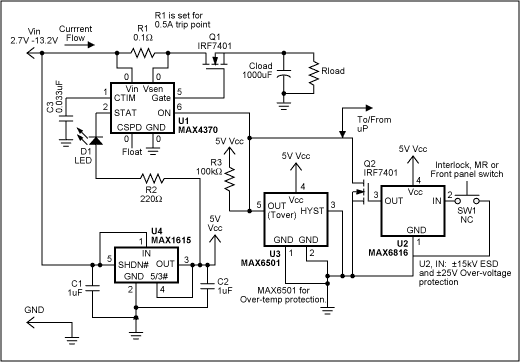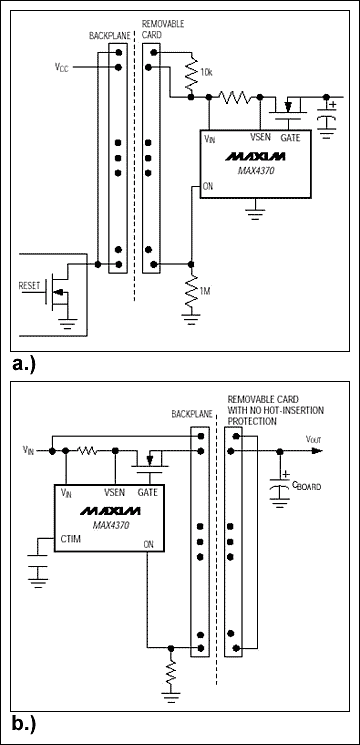Many applications must be able to automatically disconnect power from an operating circuit. Such applications include thermal shutdown of high-voltage power supplies in radar and X-ray systems, shutdown to limit inrush current during power-up or hot-swapping of plug-in circuits, and shutdown to ensure that a card is properly seated before power is applied. In general, power should remain off following any system fault.
Figure 1 is a flexible circuit that limits current or removes power in response to a command from the user, or other fault-indicating signal. It accommodates manual-reset (MR), over-temperature, and interlock-switch inputs.

Figure 1. This circuit provides general over-current and over-temperature protection.
U1, for instance, is a circuit-breaker IC designed to offer protection in hot-swap applications. Residing on either the backplane / host side or the removable-card / remote-device side of the backplane connectors, it guards against start-up faults when a card or board is inserted into a rack or host with the main power supply turned on.
Two main fault conditions are possible. Discharged filter capacitors on the card or remote device can provide a low impedance to ground that momentarily collapses the host power supply. Or, a card only partially seated in its connector can generate erroneous data. U1 prevents the first condition by regulating inrush current during a programmable start-up period, allowing the system to stabilize safely. During normal operation, two internal comparators provide short-circuit and over-current protection (DualSpeed ​​/ BiLevel capability). The second condition is handled by routing U1's current output (ON) through two pins at the outer edges of the card (Figure 2).

Figure 2. To insure properly seated pc cards on the backplane's card side (a) or host side (b), this IC (MAX4370) routes current through the outer pins of the card connector.
An internal charge pump generates controlled gate drive for an external n-channel MOSFET power switch (Q1). Following a fault condition, U1 latches Q1 off until cleared by an external-reset signal. To indicate fault conditions, connect an LED (or other fault indicator such as an audible alarm) to U1's open-drain status output (STAT). After a fault is detected, you can reset U1 by pulsing its ON pin low for 20mS minimum.
The switch debouncer (U2) has inputs protected to ± 15kV for ESD and to ± 25V for circuit faults. Its input (shown connected to a normally-closed pushbutton switch) can clear a fault on U1 or provide a manual reset. An internal pull -up to Vcc eliminates the need for an external pull-up resistor. Replacing the pushbutton switch with an interlock or SPST switch provides a power-disconnect signal, which can implement a chassis-intrusion interlock, or allow a technician to power-down the unit before swapping circuit cards. Because U2's push-pull output cannot be directly OR-connected with other signals connected to U1's ON pin, Q2 is added to create an OR-able open-drain connection.
A temperature switch (U3) adds thermal protection, and its open-drain output can be connected either directly (wire-OR'd) to other signals on U1's ON pin, or separately, back to the microprocessor. With its TO220 package option, U3 can be bolted to a heat sink, or surface-mounted (SOT23 option) close to known heat-generating sources such as R1, Q1, or the main load. In this circuit U3 provides circuit protection by issuing a power-disconnect signal when the circuit temperature becomes critical. A low-power linear regulator (U4) provides 5V to the low-voltage components U2 and U3, but U4 is not meant to provide system power to the load.
Power and Performance
The PACSystems* RX3i controller provides the foundation for Industrial Internet connectivity. It is a powerful, modular Programmable Automation Controller with a focus on high availability. The RX3i features a single control engine and a universal programming environment to provide application portability across multiple hardware platforms.
With integrated critical control platforms, logic, motion, HMI, process control and high availability based on GE Reflective Memory technology, RX3i increases system performance and flexibility.
Universal Development Environment Gets You Up and Running Faster:
The common software platform across all GE controllers, award-winning Proficy* Machine Edition* software provides the universal engineering development environment for programming, configuration and diagnostics for the entire PACSystems family.
- Programming tools such as tag-based programming, a library of reusable code and a test edit mode for improved online troubleshooting
- User-friendly environment that can increase design flexibility and improve engineering efficiency and productivity
Ge Plc 90-70 Cpu Parts,Cpu Parts,Io Bus Terminator Plug,Ge Fanuc Terminal Block
Xiamen The Anaswers Trade Co,.LTD , https://www.answersplc.com